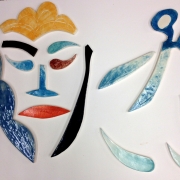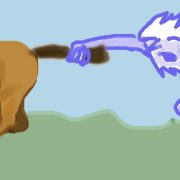Wet blanket weather
The slog up Bradlow Hill was not as exhausting this time because it had to be done very slowly and carefully to avoid any slippage and loss of dignity. It’s been raining non-stop here and the ground is saturated – so much so that every footstep has to be judged, specially going uphill, if one is to avoid the mud bath fracas of last month (see January blog). Consequently, one’s eyes are always on the ground and there is no time to look around. This meant the walk, which is 4.8 klms long and takes 7800 steps (yes, my new smartphone has the app – more about that later) was tedious, wet, and uninteresting. I did find a patch of snowdrops.
I had so wanted this to be about my trip to Holland to visit the Kröller-Müller Museum located in the Hoge Veluwe National Park in Otterlo and to look around the European Ceramic Workcentre (EKWC) in Oisterwijk, and to bring you lots of fabulous images of the trip. However, in the haste to get off the ferry, the smartphone was left on the car roof and slipped off at some point along the route leading out of the port. Contact with the port authorities has proved fruitless, so if any of you are heading for the Hook of Holland, please keep an eye out for a sad and probably very flat iphone on the tarmac of Prinses Maximaweg, where, according to my Find My app, it is still located, though the area indicated includes the sea, so it could be underwater.
As I trod warily in the mud in Frith Wood I was thinking of Holland, and the word “poppycock” came to mind, no doubt because the consistency of what I was avoiding falling into was indeed soft dung or pappekak. What other words in English derive from Dutch? My research reveals the following: yatch, booze, coleslaw, wildebeest, blunderbuss and hustle.
But then, what with the rainfall and general flooding, I realized that Holland’s relationship with water is special; they have been living below sea level quite comfortably for centuries now and have learned to take advantage of it. Water percolates through the lives of the Dutch, and it runs through the land itself. A fifth of the total surface area of the country consists of water. Nearly a third of the country lies below sea level, and without its landscape of ditches, canals, lakes, rivers, windmills, and dikes, half would be flooded.
So, no pictures of Holland, though I have used a few that are in the public domain and are not covered by copyright. The trip was enjoyable however, and the Dutch are as polite, direct, but considerate as always, except perhaps when they are driving. Being a small country, the road system too is compact and requires quick decision-making before turning off or getting in the right lane – there isn’t the distance that allows a driver to consider the options, but the Dutch are used to it and zip about with great alacrity. They are also quite tall, in fact, they claim to be the tallest people in the world, and they did invent gin. They eat more liquorice and drink more coffee than any other people …. (that’s enough. How about mentioning ceramics? – Spiro).
The exhibition The Love of Art Comes First. Art & Project at the Kröller-Müller Museum (until 25 February) highlights the significance of Art & Project based on works from the collection by artists such as Barry Flanagan, Richard Long and Nicholas Pope, of this parish, one of whose ceramic pieces stood alone surrounded by the beautiful paintings of Vincent Van Gogh. I wish I had a picture. The museum, founded by art collector Helene Kröller-Müller within the extensive grounds of her and her husband’s former estate (now the national park), opened in 1938. It has the second-largest collection of paintings by Vincent Van Gogh, after the Vincent Van Gogh Museum.
What a painter Vincent was. Up close you get to experience the wristy application of paint on canvas that makes his images move and writhe.
The EKWC in Oisterwijk is housed in a vast warehouse-like building, and is an international artist-in-residence and research centre for ceramics. Artists, designers and architects from all over the world have worked here to experiment with clay. Artists are invited whether they have worked with clay before or not, to participate in their twelve-week residencies. In a year they have about 60 different residencies out of something like 600 applications, and during their time there residents stay in the EKWC accommodation with other artists and share kitchen, studios, facilities, experience and networks. It is a welcoming and friendly set-up, and if you want to find out more, here is the link. The huge walk-in kilns make the new PAC kiln look tiny in comparison. And the coffee in the café is not bad either.
They say you learn a lot about a culture through its humour. Dutch jokes about neighbours are good-natured if crude, because, in practice, neighbours need to get along quite well. The Dutch actually don’t hate the Belgians at all. On the contrary, they find them their most sympathetic neighbours, but nevertheless, ripe for teasing:
Hoe houd je een Belg bezig?
(How do you keep a Belgian busy?)
Zet een man in een ronde kamer en zeg dat er een zak friet in de hoek ligt.
(Put the man in a round room and say there’s a bag of chips in a corner.)
On the other hand, and for the sake of balance, in the eyes of the Belgians, the Dutch are mean and stingy:
Een Nederlander werd gevraagd voor een donatie voor een verzorgingshuis.
(A Dutchman was asked to make a donation to an old people’s home.)
Hij gaf zijn vader en zijn moeder.
(He gave his father and his mother.)
The new kiln is about to be installed, and nothing has been fired now for some time, but Spring should see a renewal of activity and some interesting pieces being made. These images of ceramics are of old pieces which have not been shown for a long time or not at all. The latest news on Thelonious the pug mill is that nobody wants him because he is old and requires a three-phase connection, so sadly he is going to be sold for scrap iron – unless there is a last-minute reprieve . Thank you all, and see you next month.

Someone asked me the other day, “What’s with those clogs you keep wearing?” I replied,”Wooden shoe like to know.”




















